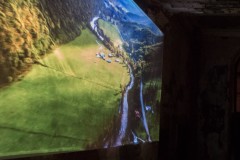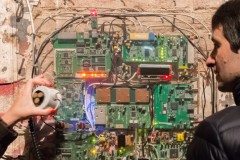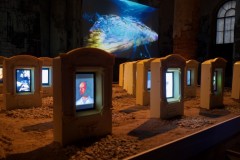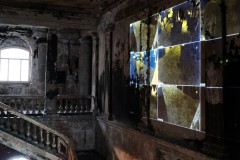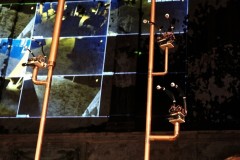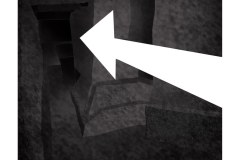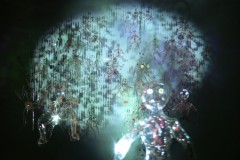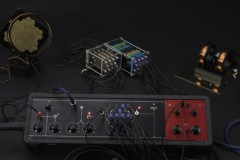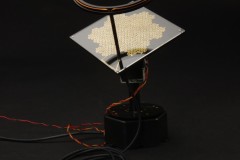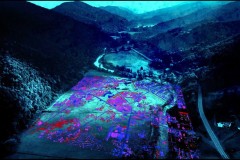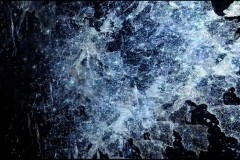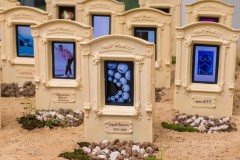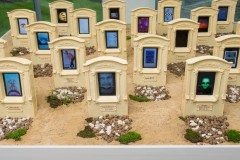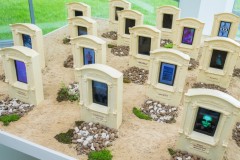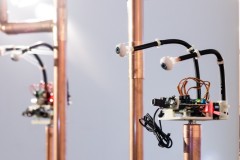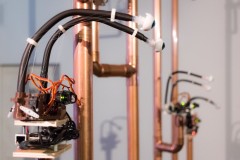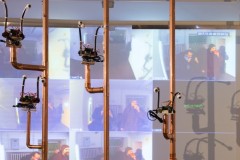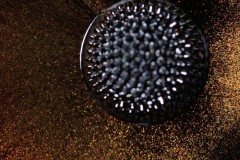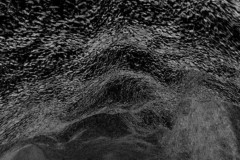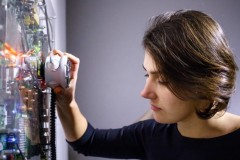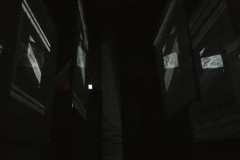WE’LL HAVE ANOTHER CHANCE
EXHIBITION PROJECT
February 2–5
Annenkirche
Curated by Anna Frants (Russia-USA), Elena Gubanova (Russia), Sergey Komarov (Russia)
Photography by Anton Khlabov, Mikhail Borisov
PARTICIPANTS
Marina Alekseyeva and Vladimir Rannev (Russia)
Sergey Denikin (Russia)
Sam Conran (UK)
Francois-Xavier de Costerd (USA)
Where Dogs Run Group (Russia)
Anna Frants (Russia-USA)
Lei Han (China)
Carla Chan (Germany – China)
Boris Shershenkov (Russia)
“Tonoptik” Group (Russia)
Sergey Karlov (Russia)
WORKS
Marina Alekseeva, Vladimir Rannev (Russia) – We Have Opened!
Video installation, 2017
With technical support of Sergey Karlov
The site-specific project in the basement of Annenkirche is about how important it is to encounter something new — notably, it is not so important what exactly as long as it is new.
Sergey Denikin (Russia) – Transparent Figures
Installation, 2018
A television signal — “white noise” — goes through the suspended figures. Letting the signal pass through them, these figures simultaneously reflect it into the space.
Sam Conran (UK) – 777 Synth
Object, 2015; performance, 2018
“777 Synth” is an alchemist approach to sound-making and ultimately a project that seeks to understand and debate the psycho-social implications that could occur when science is experienced/accessed through a commercial medium and how “signification” can be combined with the synthesizer to access and objectify the unknown. The project has ultimately been a quest to understand sounds utility in society and speculate that artificial intelligence and machine listening could be present in the way we might start to interact and value our environments.
François-Xavier de Costerd (USA) – Maybe We’ll Have Another Chance
Video installation, 2017
As the American president explains how he does not believe in global warming and climate change, a simple green alpine valley turns into a theater for all threats to its pristine setting. A storm of digital flakes made of satellite views of Las Vegas, Boston, New York, London and Paris engulfs the valley. As the president declares that we should have kept the oil from Iraq, a satellite view of Baghdad hangs over the valley… The title’s double-meaning echoes Trump’s wish to go back to Iraq and get the oil, but also our slim chance of fixing this crisis.
Where Dogs Run Group (Russia) – Media Graveyard
Interactive object, 2017
The artists suggest that people express and preserve themselves as a media message. Their goal is to change the role of a graveyard — after all, it could become a place where everyone would get a chance to meet a person whom they knew or did not know before. To preserve oneself at the media graveyard is an opportunity, without looking back at the social connections and circumstances, finally to emerge as the one whom you always felt to be or would like to become. Here, one can simply express — and preserve — oneself.
Save yourself at the media graveyard: http://cemetery.media/
Anna Frants and CYLAND MediaArtLab – Living Tapestry
Media installation, 2018
Computer Programming: Aleksey Grachev
Gadgets help us narrow down our location, take photographs, analyze, construct dynamic tables and charts, store the accumulated data in the clouds and draw conclusions based on it. They transform the “living” into “dynamic”, “warm” — into “favorable temperature setting”, and “love” — into “hormonal release”. In the installation “Living Tapestry”, robotic eyes track the viewer, registering each of his movements and creating in real time a fabric out of video fragments that is similar to “textile pixels” in the traditional tapestries. The servo-engines are clicking, and one can hear the subdued noise of the crowd — it is as if frozen imaged came to life and turned into the tapestry that has taken on a life of its own.
Lei Han (China) – Wei Shi
Video, 2017
This work plays out a tension between the form and the formless, and it aims to make connections between the seen and unseen forces at play in nature. It creates a poetic, meditative or contemplative viewing experience, which hopefully helps to evoke viewer’s aesthetic sensibilities and further one’s self-awareness. “Wei Shi’’ refers to the process of becoming. The stages of the formation of things are described temporarily. “There is a beginning’’, writes Zhuang Zi, an ancient Chinese philosopher, observing that “there is not yet beginning to be a beginning. There is not yet beginning to be not yet beginning to be a beginning.’’ At first, it is not just that there are no things, but that things have “not yet begun to be’’ in the state of being just about to become, which is to say, in the process of becoming.
Carla Chan (Germany-China) – Black Moves
Video installation, 2016
“Black Moves” is an immersive video installation. It is a spatial drama and a virtual landscape that simulates the forming and de-forming of an amorphous black mass. The installation springs from the artist’s long obsession and fascination with natural transformations, particularly formless shapes and their movement. The transformative power of natural substances such as water, rock, air and clouds produces infinite varying forms that seem both ordered and random at the same time. These magical transformations continuously disorient and fascinate the senses, creating a rich perceptual journey that is chartered for a mysterious unknown cosmic. This unknown cosmic can be seen as a representation of an external world as well as a mirror of the psyche from within, where the immanent and the transcendent are fused as one via the ever-changing audiovisuality.
Boris Sheshenkov (Russia) – Electromagnetic Ectype #1: Net Bas-Relief
Installation, 2016
“Net Bas-Relief” is a series of object compositions out of computer components. Digital devices of hard-wired and wireless network communication, that compose a loop network while exchanging data, generate the “garbage” electromagnetic radiation that includes audio frequencies. A relief of sorts is created that is impossible to see. One can only hear it with the help of special devices that transform electromagnetic oscillations into sound oscillations.
Tonoptik (Russia) – Leuchtkraft
Interactive audio-visual installation, 2017
“Leuchtkraft” is German for “luminosity“. This is one of the main characteristics of a quantum accelerator that denotes the intensity of colliding of particles from intersecting beams. The installation of Tonoptik group is an artistic interpretation of certain principles of the work of hadron colliders. Much like quantum accelerators, this work studies various effects by using a multilayered configuration (representation of detectors) and video projection (particle beams) from two opposite directions. Thanks to the sound component and the installation’s general dynamics, a unique composition is created that the viewers can observe from different angles.
CYFEST is sponsored by:


11th CYFEST in St. Petersburg, Russia
CYFEST 2018 St. Petersburg – Program

